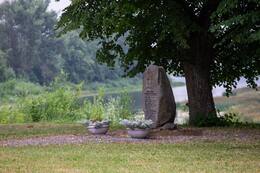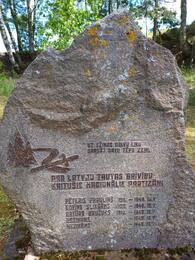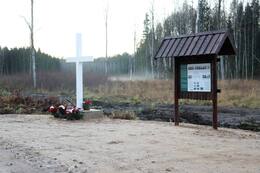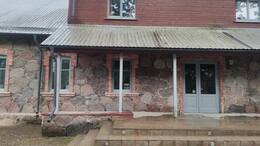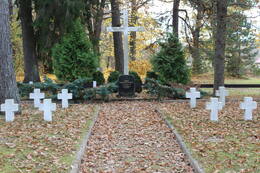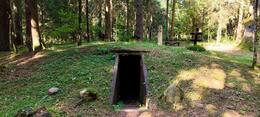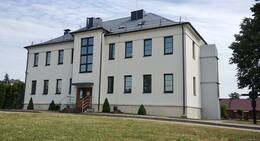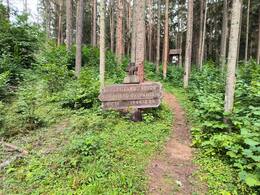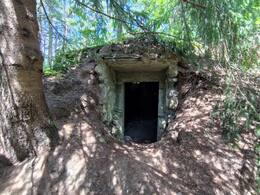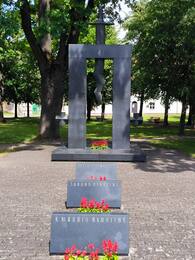The Sites of Battles of Latvian and Lithuanian National Partisans – the Forest Brothers
Memorial stone to Rihards Pārups' national partisan group
Located on Riga Street near the Krustpils Lutheran Church.
On September 22, 1996, a memorial stone was unveiled in Krustpils to Rihards Pārups and the national partisan group he led. The memorial stone was created by sculptor Ilgvars Mozulāns, and its creation was financially supported by the Speaker of the Saeima, Ilga Kreituse. This event was organized by the board of the Latvian National Partisan Association.
To the national partisans of Rihards Pārup,
who were murdered by a Cheka special group
Richard Parups (1914 – 2nd July 1946)
Group commander
Richard Stulpins (1923 – 1946. 2. VII)
Alberts Avotiņš (1912 – 2 July 1946)
Erik Juhna (1928 - 2 July 1946)
Aleksandrs Lācis (1919 – 2 July 1946)
Peter the Bear (1921 – 1946, 2nd July)
Jānis Ēvalds Zālītis (Āboliņš) (1911 – 1946, 2nd July)
Siegfried Bimstein, Theodore Schmidt (… – 2 July 1946)
Uldis Šmits (... - 1946. 2. VII)
Peter Lazdans (1926 – 1947)
Erik Konval (1929 – 1947. VI)
Niklāss Ošiņš (1908 – 12 October 1954) – executed in Riga
Alberts ħiķauka (1911 – 1972 II) – imprisoned in the Mordovian camp
Rihards Pārups was born on June 11, 1914 in “Kaķīši” of Krustpils parish. During World War II, he was a sergeant of the anti-tank division of the 15th Latvian division. He participated in national partisan operations in the Jēkabpils and Madona areas and was a member of the National Resistance Movement, the leader of a unit in the Jēkabpils and Madona areas. Rihards Pārups fell in battle with Cheka troops on July 2, 1946 in Vietalva parish. Unfortunately, the place of burial is unknown. A memorial plaque has been installed in the Riga Brothers' Cemetery. In the autumn of 1945, a national partisan group was formed in Jēkabpils district, led by R. Pārups. During its short existence, it participated in more than twenty armed clashes with units of the then Ministry of the Interior. The report of the Cheka Colonel Kotov to the Riga leadership states that the activities of the Soviet government in the Jēkabpils and Madona districts were effectively paralyzed during this time as a result of the group's activities. The national partisans led by R. Pārup found and destroyed several lists of deportations, thus saving the lives of many people. The leadership of the Security Committee, unable to destroy the national partisan unit in open battle, infiltrated it with four people from the Cheka special group, who shot ten partisans of the unit, including R. Pārup. In 1947, two more were shot near Jaunkalsnava, and in 1951 — one member of this unit. After twenty-five years of hard labor in a Mordovian camp, the fourteenth partisan of the group led by R. Pārup died a few days before liberation.
Memorial site to the members of the P. Prauliņš national partisan group and the site of the bunker
Pēteris Prauliņš (1911-1949) Birži parish national partisan group was part of the group led by Mārtiņš Pokļevinskis (1902-1951). The group carried out several partisan actions, in which Soviet collaborators were punished and food and property of the economic institutions of the occupation authorities were requisitioned. P. Prauliņš's group partisans did not observe sufficient conspiracy, many persons visited their settlement, which created an opportunity for betrayal. The lack of military experience was one of the shortcomings of the partisan armed movement.
P. Prauliņš's partisan group in the Kalna forest in the Birži parish was destroyed on May 16, 1949, during an operation by the Ministry of State Security of the Latvian SSR, in which military units also participated. The forest brothers had set up a bunker with perimeter defense, which was well camouflaged and was located at an undetermined height in a swampy area. The partisans fiercely resisted the Cheka troops for at least 40 minutes, but the entire group fell: Pēteris Prauliņš, Artūrs Bružuks, Jānis Kalvāns, Edvīns Slikšāns and Francis Skromanis. The shot forest brothers were thrown near the parish house, but their remains were later buried in nearby gravel pits. Irma Bružuka was seriously wounded, who was captured and died on May 17 in Jēkabpils Hospital. She was buried outside the cemetery, but when the cemetery was expanded after Latvia regained its independence, a monument was placed on her grave.
A memorial stone to the partisans of P. Prauliņš' group in Kalna parish was consecrated in November 1998. The site of P. Prauliņš' bunker is located in section 4 of Vidsala 99th block, Kalna parish. The stone on which P. Prauliņš sat has been preserved.
Memorial site at the site of the national partisan battle of February 13, 1945 in the Diamond Forest of Kalna Parish
The memorial site was created on the regional road P74 Siliņi - Aknīste, 12 kilometers from Aknīste, turning onto the Latvian State Forest "Žagari ceļa".
The vast forest massif of the northern part of Elkšķi parish already at the end of the summer of 1944 became a gathering place for people who were preparing for armed struggle against the Soviet occupation power. At the end of 1944, national partisan groups began to form in the Aknīste area. A suitable place for establishing a partisan camp was the Diamond Forest , which was located on the southern edge of the Elkšķi large forest, near the Aknīste Great Swamp. There, less than 10 kilometers from Aknīste parish, the national partisans created three winter bunkers for wintering. Communications of the men gathered in the forest were ensured with the support of nearby houses - Baltimores, Gargrodes, Līči, Priedes, Krūmi and residents of other houses, neighbors and partisans.
The partisan battle with the soldiers of the Latvian SSR Ministry of State Security in the Diamond Forest took place on February 13, 1945. The Chekists, having taken hostages, drove them forward to reveal the partisan bunkers. The Forest Brothers, seeing the danger, opened fire, not sparing the hostages. 10 representatives of the Soviet occupation troops, eight national partisans and four hostages fell in the battle. Despite the losses of the Forest Brothers, the Chekists failed to capture the partisan bunkers. The surviving partisans waited for darkness and left the settlement. The Chekist soldiers wounded in the battle, groaning, were unable to leave the battlefield. After this battle, which can be considered the forest brothers' first "baptism of battle", the partisans felt like brothers and the rifle seemed more precious than anything, like the only reliable savior.
The White Cross and information stand in the Diamond Forest were installed on Lāčplēsis Day - November 11, 2022. The creation of the memorial site was supported by the Jēkabpils regional government, the association "Tēvzemes sargi" and the Latvian State Forests. The author of the content of the information stand is historian Haralds Bruņinieks.
Former Susēja parish house, site of attack by national partisans on July 7, 1945
Today, the former Susėja parish house houses the Sanssouci residence center. The facade of the building still bears traces of the attack left by bullets fired by national partisans during the attack on July 7, 1945.
The former Susēja parish house, which at that time functioned as the local executive committee of the Soviet occupation authorities, suffered an attack by the Sēlija national partisans on July 7, 1945. The attack on the Susēja executive committee was part of a wider national partisan campaign and took place simultaneously with the attacks on the Vilkupe butter factory and the house of the destroyer Kaunackas.
According to the instructions of the commander of the Susėja national partisan group, Albert Kaminskis (1920-1946), the Forest Brothers were to destroy the security of the local executive committee, take weapons, militia uniforms, documents and damage telephone communications. About 17 Forest Brothers under the leadership of the Lithuanian partisan commander Jozas Kuveikis participated in the attack on the Susėja executive committee. The battle lasted 15-20 minutes, one Lithuanian partisan fell during the firefight, and on the other side - a fighter of the destroyer battalion Jānis Kakarāns. During the firefight, the windows of the executive committee were broken and the telephone was damaged.
The second attack on the Susēja Executive Committee took place on July 16, 1945, when a prolonged firefight took place between the Forest Brothers and fighters of the destroyer battalion who had sought refuge in the Executive Committee building. During the battle, a group of Soviet soldiers came to the aid of the latter, who opened machine-gun fire from the flank and forced the partisans to retreat. At least five Forest Brothers and five destroyers fell in the battle. The attacks on this administrative object of the occupation power confirmed the nature of the armed resistance of the partisan war and were a warning about the people's resistance to the Soviet occupation power.
Monument to the National Partisans of Susėja
The Susēja national partisan unit was formed from smaller fragmented forest brotherhood groups, because initially there was no leader who could unite them. For a short time, Artūrs Grābeklis tried to coordinate the activities of the Susēja partisans, and later Markejs Gorovņovs, who fell in the winter of 1945. The Susēja national partisan unit was strengthened after the former legionnaire Alberts Kaminskis arrived in Courland, Sēlija, after the general capitulation of Germany. He established stricter discipline and united smaller groups for a joint fight against the Soviet occupation power. Cooperation was also established with forest brotherhood groups from nearby parishes and areas, especially with the Gārsene group and Lithuanian partisans who had settled on the border of Lithuania and Latvia.
In the early stages of the armed movement, it is clear that the Forest Brothers were not prepared for attacks, unable to occupy either the Kaunacki farmstead or break into the building of the Susėja executive committee. The partisans suffered losses and were unable to resist the Cheka troops for a long time, and the main method of fighting was to think about retreating in time. There was also a problem with the supply of the partisans. Despite the existing difficulties, the Susėja national partisan unit was still able to actively resist the Soviet occupation power in the first post-war years. This partisan group ceased to exist after the fall of its commander A. Kaminskis on May 14, 1946. This was also followed by the legalization of several Forest Brothers, as well as joining other partisan groups.
The monument to the national partisans of the Susēja company was opened on November 11, 1997, at the initiative of Gunārs Blūzmas, a researcher of the history of the national partisans of Sēlija. Next to the names of the fallen Susēja national partisans, a text is carved into a roughly worked boulder under the sign of a cross: “On the head of a hedgehog, I ordered you to protect your father’s land.” The monument mentions those who fell in the attack on the Susēja executive committee on July 16, 1945 - Jānis Grābeklis (1923-1945), Ādolfs Rācenis (1919-1945), Broņislavs-Arvīds Bīriņš (1919-1945) and Edgars Ērglis (1920-1945), and later the names of the murdered Līna Kaminska (1917-1945) and Albert Kaminskas (1920-1946) were added. The monument is missing the names of Arnolds Dombrovskis (1923-1945) and other national partisans who were active in the Susēja national partisan groups and who fell in 1945-1946.
Cemeteries of the National Partisans of Sēlia
The Sēlija National Partisan Brothers Cemetery was opened on October 30, 2004 with the support of the Latvian Ministry of Defence and the Aknīste Municipality. The partisans who fell in the battle of December 19, 1949 in the Dimantu Forest of Kalna Parish are buried there: Alberts Karankevičs (1914-1949), Vilis Tunķels (1911-1949), Arnolds Tunķels (1926-1949), Osvalds Tunķels (1929-1949), Ēvalds Kundzāns (1927-1949).
In 2005, the partisans who fell in the battle of February 13, 1945 in the Elkšņi Forest were also reburied here: Juris Alfreds Voldemārs Lācis (1908-1945), Eduards Kaminskis (1910-1945), Osvalds Mežaraups (1911-1945), Alberts Mežaraups (1915-1945), Antons Bružiks (1911-1945), Jānis Britāns (1926-1945) and one unknown. The common cemetery also contains the remains of Marta Mežaraupe (1907-1945), Alberts Lācis (1902-1945), Juris Resnītis (1901-1945) and Pēteris Bite (1907-1945), who were taken hostage by the Soviet occupation authorities and fell during the battle, as well as Voldemārs Otto Sātnieks (1911-1950), a fallen partisan of the Indāns-Grāvelsons group. The Aknīste Brothers' Cemetery also houses a monument to Alfreds Silaraup (1925-1946), a national partisan of the Aknīste Company, who fell during a Cheka operation on July 30, 1946, on the narrow-gauge railway in the Elkšņu Forest.
At the foot of the White Cross erected at the Brothers' Cemetery of the National Partisans of Sēlija, a black granite stele with the emblem of the Latvian National Partisan Association and the text engraved below it, "To the National Partisans of Sēlija. You sacrificed your lives for Latvia in the fight against the communist occupation regime in 1944-1954." There is also a memorial stone in the cemetery with the inscription "There are tears that will be shed in silence. There are scars that will not heal when healed," which was erected by Stanislava Šadurska at the beginning of the Awakening near the pit where the Chekists buried the national partisans and hostages who had fallen the day before on February 14, 1955.
Partisan bunker and memorial cross in Plunksnotiai forest
Partisan Bunker and Memorial Cross can be found by turning off the regional road 3604 (Rokiškis-Maineivos- Naujasodė) between Juodupė and Žiobiškis in the direction of Plunksnočiai Forest.
In 1947, the partisans of the Gediminas Company of the Kunigaikštis Márgiris (King Márgiris) Unit, led by Juozas Bulavas- Iksas, were located in the Plunksnočiai forest stand. Until 1948, they did not have a permanent wintering place, so they took refuge with people who supported them. After World War II, Plunksnočiai Forest was a swampy area with a small mound in the middle of the swamp. In 1949, the partisans set up a hiding place there. However, they were betrayed by an infiltrated Russian security agent, who knew the location of the bunker. On 14 November 1949, after the partisans had fallen asleep, he threw antitank grenades into the bunker. Seven partisans died.
The partisan bunker has been restored and a memorial cross with the names of those who died there has been erected. Today, the surrounding forest is green and walkable. A monument and information signs have been erected in a small square a few dozen metres from the bunker, pursuant to the initiative of the Young Riflemen of Rokiškis.
Museum of the History of Freedom Struggles in Obeliai
The Museum of the History of Freedom Fights is located on Vytauto Street, Obeliai (Obeliai-Zarasai road KK117) on the left side (a road sign is installed on the road).
Founded in 1998, the museum introduces the development of the Lithuanian state, the history of the Obeliai region and Lithuanian folk art. A large part of the exhibition is devoted to the theme of freedom fights.
The evidence of the freedom fights was collected and donated to the museum by a teacher and former partisan, Andriejus Dručkus (1928–2018).
In addition to the themes of Soviet repressions, deportations, the partisan war, the anti-Soviet resistance movement, and the rebirth of independence, which reflect the experiences of the Obeliai region, the museum also stands out due to its peculiar accents. The museum presents the history of the erection, destruction and restoration of the unique monument dedicated to the participants of the June 1941 uprising and the victims of Soviet terror. An overview of the Lithuanian defence system after 1990 is also provided, as well as uniforms of the Lithuanian Armed Forces and other services. The open-air exhibition of the museum has replicas of a Lithuanian partisan bunker and a Siberian barracks for deportees on display. The sites can be visited individually, and special educational programmes are also offered, which enable visitors to experience the everyday life of partisans and deportees to understand what it was like to live in a bunker or barracks.
Antazavė Battle Site and Partisan Dugout Shelter at Lake Vincežeris
The site can be accessed from the town of Antazavė by forest roads.
At the end of 1944, the Lokio Unit of Lithuanian partisans was formed in the area of Antazavė in north-eastern Lithuania. It was led by a former Lithuanian Army officer, Captain Mykolas Kazanas. The unit established five dugout shelters at Lake Vinčežeris, in the uplands of the dense spruce and pine forests of Antazavė.
On 26 December 1944 (27 December according to other sources), the Battle of Antazavė Forest took place here. It was one of the largest partisan battles in eastern Lithuania. The partisan camp was surrounded by Soviet Army units from Utena and Zarasai, as well as soldiers stationed in Antazavė Parish. After a day-long struggle, 85 partisans managed to break the siege and successfully retreated. One partisan died during the retreat.
Currently, two partisan dugouts have been built on the site of the partisan camp, and battle positions, a cross, a memorial plaque, and benches for visitors to the camp have been installed at the site. The partisans’ dugouts are outstanding in terms of their size – they are relatively large and massive underground structures and differed significantly from partisan bunkers that were later built in the forests of Lithuania.
Museum of the Battles for Freedom in Utena
The museum is located in Utena, near the junction of the Kaunas-Daugpilis (A6) and Vilnius-Utena (A14) trunk roads. The museum was established in 2015 at the former narrow gauge railway station building of Utena. The museum claims to be a form of poetry that tacitly exposes the post-war truth. The exhibition “A Common European Identity in the Context of Totalitarian Regimes” offers to explore the past of Lithuania and Europe through the history of one Lithuanian region. It tells the story of secret documents and the division of Europe in 1939, the Soviet occupation of Lithuania, the forced participation of Lithuanians in World War II, exile, post-war resistance and the organisation of collective farms in the Utena region. The painful events of 1940–1965 in the Utena region and the events in Lithuania are contrasted with life behind the Iron Curtain. The history of the narrow-gauge railway station also has tragic pages. From here, in 1941 and from 1945–1953, train cars with deportees were sent to Siberia.
Along the Trails of the Partisan Battles of the Algimantas Military District
Located in Šimonys Forest, along road No. 1216 (a sign and a stand have been installed). Šimonys Forest was known in the post-war Lithuanian partisan struggle as the centre of activity of the largest partisan unit in Aukštaitija, the Algimantas military district. Approximately 200 partisans were operating in the area in 1945, while by 1952, there were only 20–30. From 1947 to 1949, the Šimonys Forest was used by the commander of the East Lithuania (King Mindaugas) partisan territory, Captain Jonas Kimštas-Žalgiris, and in 1949, by the commander who took over from him, Antanas Starkus–Montė, as hiding places – command posts from which the partisan movement in Aukštaitija was coordinated. The route of the partisan battles of the Algimantas military district invites you to get acquainted with six partisan hideouts of the Algimantas military district, created by the partisans of the Žalioji, Šarūnas and Kunigaikštis Márgiris (King Márgiris) units, who hid and fought here. There are two walking routes of different lengths (5 and 10 km) in Šimonys Forest, which invite you to follow the paths of the partisans.
Eastern Lithuania (King Mindaugas) region Lithuanian partisan command post
After driving past Andrioniškis Cemetery (there is a signpost), there is a preserved hideout – a command post. From 1944– 1949, a command post of the Lithuanian partisans of the Eastern Lithuania (King Mindaugas) region operated in this hiding place. In the summer of 1944, Balys Žukauskas, with brothers Petras and Juozas Jovaišos, established the hiding place to evade the mobilisation announced by the Red Army in 1944. At the end of 1945, Antanas Slučka-Šarūnas started to use the hiding place. He was the first one to form a partisan unit in the Troškūnai area and later united the partisans of Rokiškis, Anykščiai, Kavarskas, Troškūnai, and Andrioniškis to form the Šarūnas Unit. In 1947, A. SlučkaŠarūnas became the commander of the Algimantas district, and in 1949 – the commander of the Eastern Lithuania partisan region. This means that from 1949, the hiding place became the command post of the Lithuanian partisans in the Eastern Lithuania region. The hiding place, which had successfully sheltered partisans for five years, was betrayed on 28 October 1949. The farm where the partisans were hiding was besieged by KGB troops; the partisans refused to surrender and blew themselves up.
The bunker has been preserved, and a cross and a monument to the fallen have been installed.
Monument dedicated to Algimantas Military District partisans
The monument is located in the centre of Troškūnai, Anykščiai district, near the Church of Holy Trinity. During the partisan war of 1944–1953, the territory of Lithuania was divided into nine partisan military regions. From 1947–1950, partisan units of the Algimantas region of Lithuania, the establishment of which is closely related to Troškūnai, were active in the Panevėžys and Anykščiai area. The inhabitants of this town organised partisan units in Aukštaitija. The first partisan commander of the Algimantas region, Antanas Slučka-Šarūnas, was born and lived in Troškūnai.
In 1996, pursuant to the initiative of the Genocide and Resistance Research Centre of Lithuania, a monument dedicated to the partisans of the Algimantas Military District was erected in Troškūnai. The monument was created by sculptor Jonas Jagėla and architect Audronė Kiaušinienė. The main part of the monument is a black stone gate that symbolises the fallen defenders of the homeland. The bronze crosses on the sides of the gate symbolise the Christian faith, while the bronze sword, like the sword of St Michael the Archangel, symbolises the light of faith and hope. In the square in front of the monument, a black stone plaque commemorates the three units of the Algimantas region: Šarūnas, Žalioji and Kunigaikštis Márgiris.




